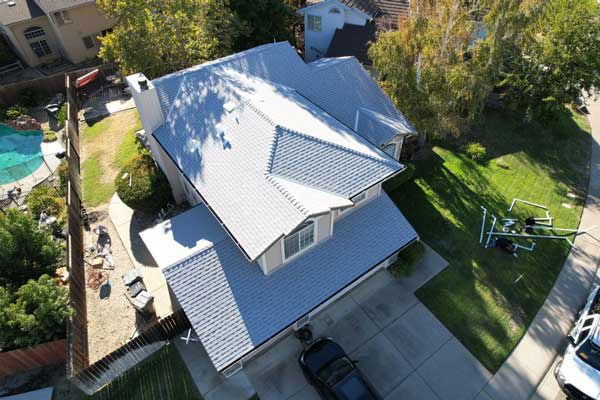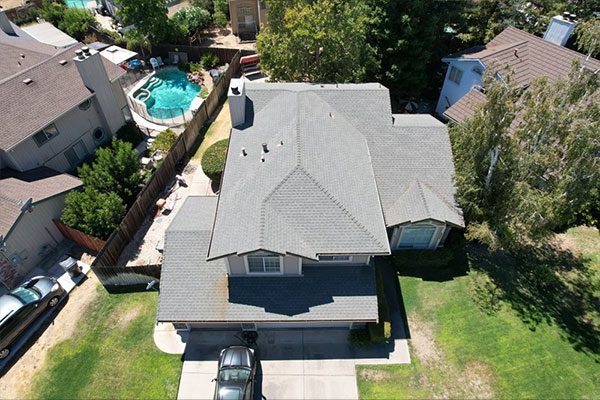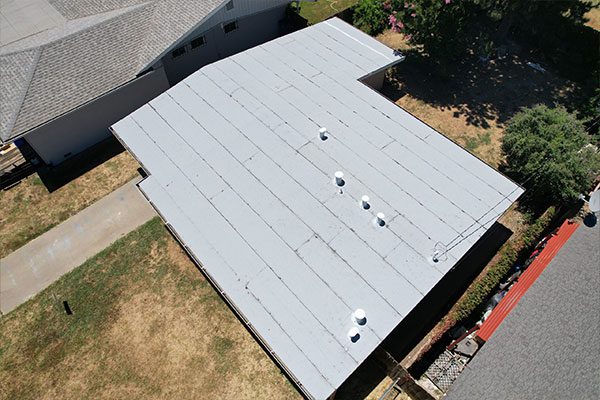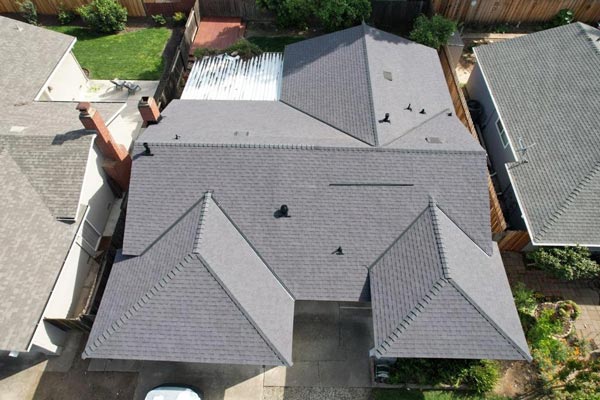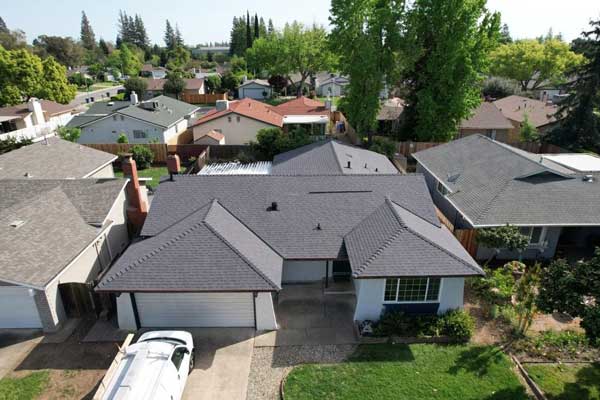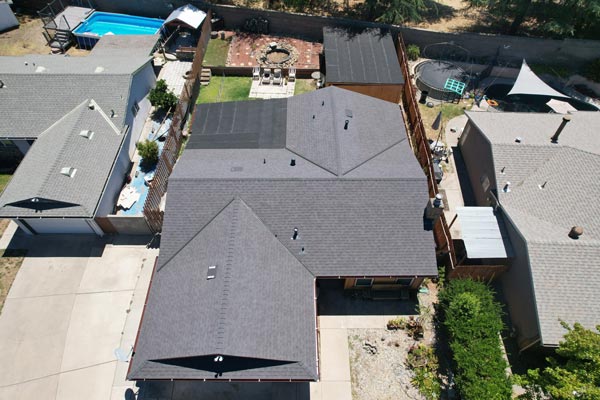Cool Roof/Energy Efficient Roofing Sacramento
Cool roofs are becoming more and more popular in Sacramento, not only because they are eco-friendly, but because they are also very functional. Cool roofs have the added benefit of reducing the amount of energy that is used to keep the temperature of your home’s interior cooler in the summer, thus reducing energy costs. This type of roofing is made up of a number of special energy efficient roofing materials and layers that help to keep the roof cooler in summer. Cool roofs increase the roof’s thermal insulation. This insulation can lower your home’s energy costs by as much as 50%, and it can also reduce the amount of air conditioning needed in the summer.
According to the EPA, Cool roofs also offer reduced air pollution and greenhouse gas emissions: By lowering energy use, cool roofs decrease the production of associated air pollution and greenhouse gas emissions.

GET YOUR SEASONAL DISCOUNT
Cool Roof Benefits
You can make your home more eco-friendly and energy-efficient with a cool roof. Cool roofs use a reflective roofing technology that reflects the sun’s rays and heat away from your roof. This will help reduce the heat transferred to your attic and reduce your cooling costs, energy consumption, and air pollution. Additionally, cool roofs can help reduce greenhouse gas emissions, making your home more sustainable and environmentally friendly. Investing in a cool roof can be an excellent way to save on energy costs and make a positive impact on the environment.
How Does a Cool Roof Work?
A cool roof is a roofing system that is specifically designed to minimize a building’s interaction with UV rays. These roofs are made using materials that are both heat-resistant and light in color, typically reflecting sunlight rather than absorbing it. The combination of heat-resistant materials and light color helps the property consume less energy and reduce the need for air conditioning.
One of the key elements of a cool roof is its ability to reflect sunlight. Light-colored materials have a higher solar reflectance, which means they reflect a larger percentage of the sun’s rays back into the atmosphere. This reduces the amount of heat transferred into the building, keeping the interior cooler.
Cool roofs also have a high thermal emittance, which is their ability to radiate absorbed heat. This means that even if some of the sunlight is absorbed by the roof, the heat is quickly released back into the atmosphere. By efficiently radiating heat, cool roofs prevent the building from becoming excessively hot.
By limiting the amount of heat absorbed by the roof, cool roofs can significantly reduce the energy consumption of a building. They help to lower the need for air conditioning, which in turn reduces both energy costs and carbon emissions. This is particularly beneficial in hot climates or during the summer months when cooling demands are high.
Additionally, cool roofs can contribute to the overall comfort of the building’s occupants. By keeping the interior temperature lower, they create a more pleasant living or working environment. This can lead to increased productivity, improved well-being, and reduced reliance on artificial cooling systems.
In conclusion, a cool roof works by employing materials that are heat-resistant and light in color, which reflect sunlight and reduce the absorption of heat into the building. This energy-efficient roofing system helps to lower energy consumption, decrease the need for air conditioning, and create a more comfortable indoor environment.
Get Started Today
NO NEED TO WAIT-FINANCING AVAILABLE
916-800-7200
Book Your Appt
Cool Roof/Energy Efficient Roofing FAQs
Cool roofs, which are designed to reflect more sunlight and absorb less heat compared to traditional roofs, can be an affordable option for homeowners and businesses. While the pricing of roofing products depends on various factors such as materials, installation, and geographic location, many cool roof options are available at similar costs to traditional roofs with comparable features.
It is worth noting that certain cool roof products may have a slightly higher upfront cost compared to conventional roofing materials. However, the additional investment in a cool roof can often be recouped through energy savings over the long term. The energy efficiency of cool roofs helps to reduce the heat absorbed by buildings, resulting in lower cooling costs during hot weather. By lowering the demand for air conditioning, cool roofs can significantly reduce energy consumption and utility bills.
Moreover, cool roofs offer additional benefits beyond energy savings. They can extend the lifespan of the roof by reducing thermal stress and minimizing temperature fluctuations. This can result in lower maintenance and replacement costs in the long run.
To make an informed decision about the affordability of cool roofs, it is recommended to consult with roofing professionals who can provide accurate estimates based on specific requirements and local factors. Additionally, it is crucial to consider the potential energy savings and long-term benefits when evaluating the overall cost-effectiveness of cool roofs.
Cool roof materials can have a longer lifespan compared to traditional roofing materials.
Cool roofs are designed to reflect more sunlight and absorb less heat compared to traditional roofs. This is achieved through the use of special materials and coatings that have high solar reflectance and thermal emittance properties. By reflecting a larger portion of the sun’s rays, cool roofs can significantly reduce the amount of heat transferred into the building, resulting in a cooler interior and lower energy consumption for air conditioning.
In terms of durability, cool roof materials are generally as robust as traditional roofing materials. They are designed to withstand various weather conditions, including high temperatures, UV radiation, rain, and wind. Cool roof coatings are often UV resistant, preventing degradation and fading over time. Additionally, cool roofs can reduce the thermal stress on the roof, which can extend its lifespan.
Moreover, cool roofs can provide additional benefits such as reducing urban heat island effect, lowering greenhouse gas emissions, and contributing to a more sustainable environment. They can also qualify for certain energy efficiency incentives or certifications, which can provide further financial benefits.
It is important to note that the durability and longevity of any roofing material depend on proper installation, regular maintenance, and adherence to manufacturer’s guidelines. Hiring a professional roofer with experience in installing cool roofs is essential to ensure optimal performance and longevity.
In conclusion, cool roofs are not only energy-efficient and cost-effective, but they can also be durable and reliable in providing long-term protection for residential and commercial buildings. Their ability to reduce heat absorption, lower cooling costs, and contribute to environmental sustainability make them a great investment for those looking for long-term savings and a greener footprint.
Installing a cool roof can lead to significant energy savings. On average, you can expect to save between 7% to 15% of your total cooling costs. This is due to the cool roof’s ability to reflect more sunlight and absorb less heat compared to traditional roofs. By reflecting more sunlight, the roof prevents excessive heat from entering your building, reducing the need for air conditioning and ultimately lowering energy consumption.
In addition to the direct energy savings, a cool roof can also contribute to the longevity of your air conditioning system. During hotter times of the day and year, air conditioning units often have to work harder to maintain comfortable indoor temperatures. This increased strain on the system can lead to more frequent breakdowns and a shorter lifespan. However, with a cool roof in place, the reduced heat absorption and lower indoor temperatures can alleviate some of the strain on the air conditioning system, potentially prolonging its life and reducing repair and replacement costs.
It’s important to note that the exact energy savings will vary depending on various factors such as the climate in your region, the size of your building, insulation levels, and other energy-efficient measures in place. However, the average range of 7% to 15% is a good estimate to consider when evaluating the potential energy savings of installing a cool roof.
Cool roofs are designed to reflect more sunlight and absorb less heat compared to traditional roofing materials. Here are some types of cool roofing materials commonly used:
1. Reflective Coatings: Cool roof coatings are typically applied over existing roofs and can be made from materials like elastomeric coatings, acrylics, or silicone. These coatings contain reflective pigments that help reflect sunlight and reduce heat absorption, thus keeping the building cooler.
2. Tiles: Cool roof tiles are usually made from materials such as clay or concrete. These tiles come in various colors and finishes, including light-colored or reflective options. Light-colored tiles can reflect a larger amount of sunlight, lowering the temperature of the roof and the building beneath.
3. Shingles: Cool roof shingles are similar to traditional asphalt shingles but are designed to be more reflective. They are manufactured with special pigments or reflective granules that help reduce heat absorption. These shingles come in a range of colors and styles to suit different architectural preferences.
4. Metal Roofing: Metal roofing is a popular choice for cool roofs due to its inherent reflective properties. Metal roofs can be made from materials like aluminum, steel, or copper and are often coated with reflective finishes or paints. They effectively reflect sunlight and can significantly reduce heat transfer into the building.
It’s important to note that cool roofing materials are not limited to these options. Other materials like single-ply membranes and modified bitumen can also be used for cool roofs depending on specific project requirements and regional regulations. When considering cool roofing materials, it’s advisable to check for Energy Star or other relevant certifications that validate their energy-efficient properties.
Yes, we offer financing options for cool roofs and any other roof replacement/new roof installation. Contact us today for a free estimate and financing discussion.
GET YOUR SEASONAL DISCOUNT


Service Areas
- Sacramento
- West Sacramento
- Elkgrove
- Citrus Heights
- Davis
- Folsom
- All of Sacramento County
Roofing Services
- Shingle Roof Replacements
- Cool Roofs
- Clay Tile Roof Replacements
- Torch Down Roofing
- Metal roofing
- Concrete Tile Roofinf
- Shake/Wood Roofing
Home Improvement Services
- Roof Insulation
- Siding
- Rain Gutters
- Interior Painting
- Exterior Painting
- Replacement Windows
- Energy Efficient Windows

